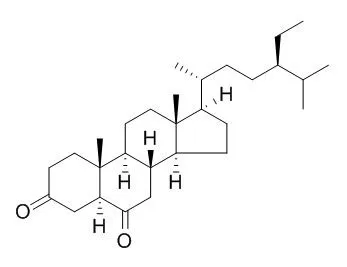| Animal Research: |
| J. Agric.Food Chem.,1994, 42(7):1561-2. | | Boll weevil antifeedants from Eleocharis dulcis Trin.[Reference: WebLink] |
METHODS AND RESULTS:
Six compounds were isolated from the CH2Cl2 extract of eleocharis dulcis Trin. They are hexacosanoic acid, 5 alpha-Stigmastane-3,6-dione, beta-sitosterol, stigmasterol, betulin, and tricin.
CONCLUSIONS:
5 alpha-Stigmastane-3,6-dione, betulin, and tricin showed antifeedant activity against boll weevils. |
|
| Structure Identification: |
| Nat Prod Res. 2013 Aug;27(15):1404-7. | | Triterpenoid profile of flower and leaf cuticular waxes of heather Calluna vulgaris.[Pubmed: 23148482] |
METHODS AND RESULTS:
Analysis of the main triterpenoid profile of chloroform-soluble cuticular waxes of heather flowers and leaves by GC-MS revealed the following composition: four ketones - α-amyrenone, 4-epi-friedelin, friedelin and taraxerone and seven steroids - campesterol, cholesterol, sitostanol, sitosterol, stigmasterol, stigmasta-3,5-dien-7-one and Stigmastane-3,6-dione. Triterpenoids accounted for 20% and 65% by mass of flower and leaf waxes, respectively, which suggest that heather leaves represent a very promising source of these compounds.
CONCLUSIONS:
Ursolic acid was the principal triterpenoid in the cuticular wax of both organs, whereas among the neutral triterpenes, friedelin and uvaol were the most abundant in flowers and leaves, respectively.
This report provides the first thorough overview of the triterpenoid composition of cuticular waxes of heather. |
|






 Cell. 2018 Jan 11;172(1-2):249-261.e12. doi: 10.1016/j.cell.2017.12.019.IF=36.216(2019)
Cell. 2018 Jan 11;172(1-2):249-261.e12. doi: 10.1016/j.cell.2017.12.019.IF=36.216(2019) Cell Metab. 2020 Mar 3;31(3):534-548.e5. doi: 10.1016/j.cmet.2020.01.002.IF=22.415(2019)
Cell Metab. 2020 Mar 3;31(3):534-548.e5. doi: 10.1016/j.cmet.2020.01.002.IF=22.415(2019) Mol Cell. 2017 Nov 16;68(4):673-685.e6. doi: 10.1016/j.molcel.2017.10.022.IF=14.548(2019)
Mol Cell. 2017 Nov 16;68(4):673-685.e6. doi: 10.1016/j.molcel.2017.10.022.IF=14.548(2019)